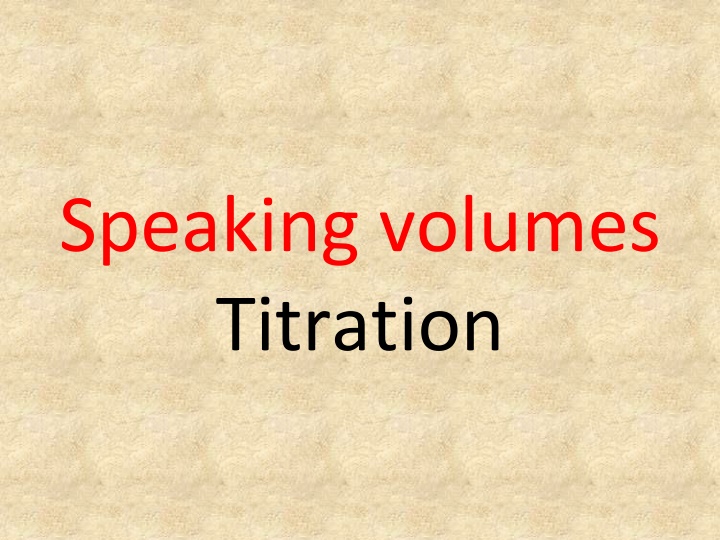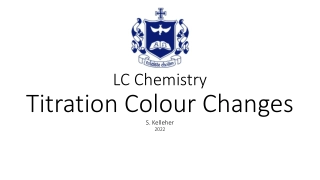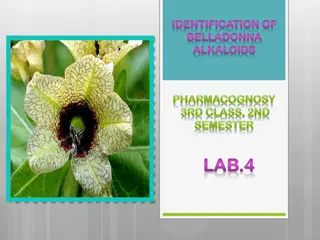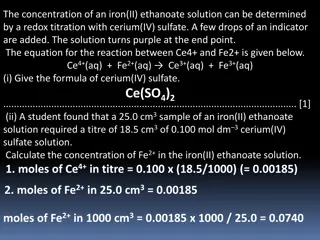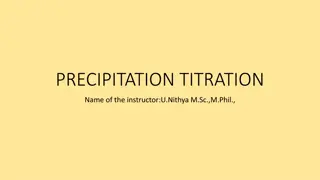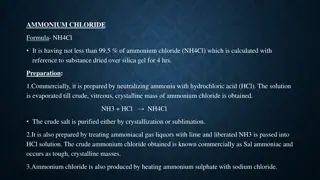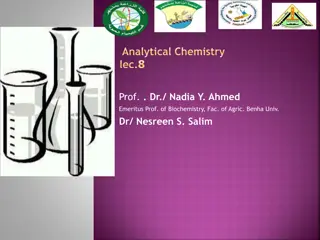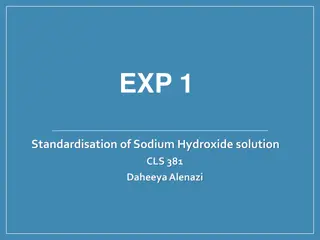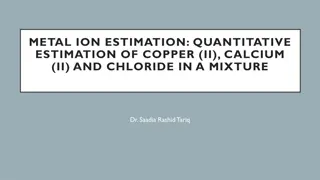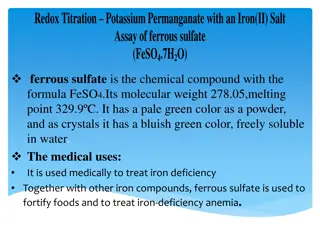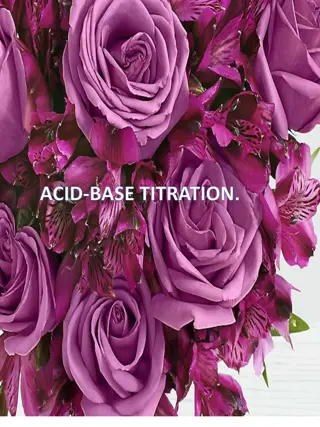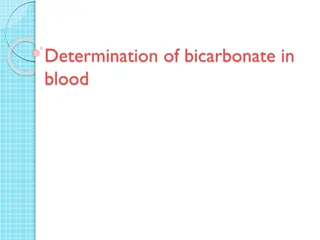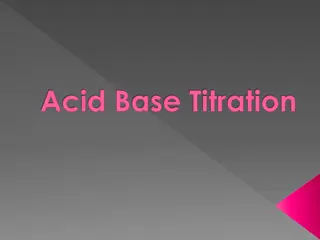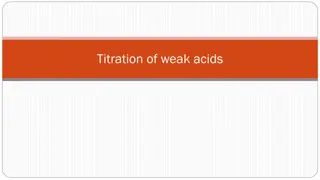Speaking volumes Titration
Discover the essential steps and key tips for successful titration experiments, including apparatus usage, indicator selection, and accurate measurements. Learn how to perform titration effectively and obtain reliable results.
Download Presentation

Please find below an Image/Link to download the presentation.
The content on the website is provided AS IS for your information and personal use only. It may not be sold, licensed, or shared on other websites without obtaining consent from the author.If you encounter any issues during the download, it is possible that the publisher has removed the file from their server.
You are allowed to download the files provided on this website for personal or commercial use, subject to the condition that they are used lawfully. All files are the property of their respective owners.
The content on the website is provided AS IS for your information and personal use only. It may not be sold, licensed, or shared on other websites without obtaining consent from the author.
E N D
Presentation Transcript
Speaking volumes Titration
Question Layout Usually Question 1 One of three practical questions of which you must do at least two Four parts 1. Using Apparatus 2. Indicator, colour change 3. Special conditions 4. Calculations
Part 1 Using Apparatus Burette Clamp it vertically Add solution drop-wise when near end point KMnO4 - read from the top of the meniscus (or from the bottom with a light behind) Don't put NaOH in burette it may react with glass of burette or block tap [not really valid now]. Rinse with deionised water to wash out any impurities Then with the solution it is going to contain to wash out the deionised water. Fill using a funnel and remove it as drops may fall from it or it may dip into the liquid giving a false level. Remove the air bubble from the tip (jet) by opening tap quickly Read from the bottom of meniscus - with eye level with this point.
Pipette Rinse with deionised water to wash out any impurities Then with the solution it is going to contain to wash out the deionised water. Fill using pipette filler - the solution may be poisonous or caustic. Read from the bottom of meniscus meniscus level with the ring on the stem eye level with this. Empty into the conical flask and touch tip against the side. DON'T BLOW it is calibrated to allow for the drop at the tip.
Conical Flask Rinse out with deionised water only. Place on white tile (to see colour change more easily Mix continuously by swirling contents. Add only a few drops of indicator (They are weak acids or bases and may upset the results) Wash down drops on the side of the flask with deionised water. (This wont affect amount of reactant in flask or change the result.)
Volumetric Flask Long thin neck to make it accurate. Read from bottom of meniscus at eye level. Make sure it is at room temperature - it is calibrated at 20oC. Mix by inverting 10 times to make sure the solution is homogeneous - long thin neck makes this necessary.
Titration Use the correct indicator Only 3 - 4 drops of indicator [weak acid-base] One rough and 2 accurate titres The two accurate should agree within 0.1 cm3 Average the 2 accurate titres Mix well by swirling (NOT shaking) Add from burette drop by drop near the end point [Point at which reaction is complete - shown by colour change Identify the standard solution [one you are given the concentration of]- for the calculations that are to follow.
Part 2 Indicator choice & colour change Indicator choice with reason Colour change(s)
Part 2 Indicator choice & colour change SASBANY(Inuit for don t eat yellow snow) Strong Acid Strong Base - Any indicator SAWBMO(Inuit for don t eat polar bears liver) Strong Acid Weak Base - Methyl Orange WASBPH Weak Acid Strong Base - Phenolphthalein WAWBNONE Weak Acid Weak Base None Indicator should change colour at a pH where pH changes rapidly during the titration
Strong versus Weak Strong: Arrhenius - dissociates fully in aqueous solution Bronsted-Lowry acid - good proton donor: base good proton accepter Weak: Arrhenius - dissociates slightly in aqueous solution Bronsted-Lowry acid - poor proton donor: base poor proton accepter Strong Acid Weak Acid Weak Base Strong Base HCl HCOOH NH4OH NaOH H2SO4 CH3COOH Na2CO3 KOH HNO3 H2CO3
Choose Indicator that Changes colour Where graph is vertical Strong base changes pH rapidly from 6.5 to 10.5 As does phenolphthalein So use phenolphthalein For weak acid with strong base Titration Curve Phenolphthalein Methyl Orange
Indicator Colours Indicator Acid Colour Red Alkaline Colour Yellow Methyl Orange Litmus Red Blue Phenolphthalein Colourless Purple
Part 3 - Special conditions Some titrations need special conditions We will deal with each of these as we describe the titration
1. Preparing a Standard Solution Standard Solution is one whose concentration is known accurately Primary Standard is one that can be made up directly using a measured amount of pure solid. To be suitable for use as a primary standard a substance must be 1. Pure 2. Very soluble 3. Have a high molecular mass
Secondary Standard: Make up a solution and then standardise this solution using a primary standard. Standardise: means to find the concentration of using titration Can't use MnO4- as Primary Standard - because it can t be got pure. Can t use iodine [I2] because it sublimes. Can t use KOH or NaOH they absorb CO2 and moisture from the atmosphere
Preparing a Standard Solution of Sodium Carbonate Weigh out an accurate mass of anhydrous crystals on a clock glass Place in beaker of deionised water Rinse clock glass into beaker using deionised water Stir until fully dissolved Pour into volumetric flask using a funnel Rinse beaker and funnel into flask Fill till bottom of meniscus is level with mark (eye also level with both) Stopper and invert 10 times to make homogeneous Long neck makes it accurate and makes mixing necessary
2. HCl NaOH titration Indicator Any strong acid/strong base Put NaOH into the flask Do with indicator to get average titre This tells you exactly how much HCl to add to neutralise the NaOH Do without indicator Evaporate water to obtain salt crystals Allow crystals to dry in air or in warm place e.g over a radiator
3. Concentration of Ethanoic Acid in Vinegar using NaOH Standard Solution Dilute by factor of 10 [25 cm3 made up to 250 cm3 in volumetric flask] Why? Acid is too concentrated Indicator Phenolphthalein (WASBPH) Pink in alkaline colourless in acid Vinegar used as a condiment or to make cellulose acetate film If you have diluted don t forget to multiply your answer by 10 at the end
4. Standardise a KMnO4 Solution KMnO4 in burette read from top of meniscus Standard solution Ammonium iron(II)sulfate Indicator none as MnO4 acts as own indicator Sulphuric acid added to ensure reaction goes to completion If not enough get brown precipitate of MnO2 Autocatalysis first drop of MnO4- goes colourless slowly Next drops faster as product of reaction (Mn2+) catalyses reaction End point when solution becomes permanent pink
5. Amount of Iron in an Iron Tablet Crush tablets (using pestle in mortar to speed up solution) in dilute H2SO4 Add 1st lot of sulfuric acid as crushing tablets to stop atmospheric oxygen oxidising Fe2+ to Fe3+ Add second lot of H2SO4 to conical flask for titration to ensure reaction goes to completion If not enough get brown precipitate of MnO2 End point when solution becomes permanent pink
6. Degree of Hydration of Sodium Carbonate Weigh out accurate mass of hydrated crystals (with water of crystallisation) Dissolve in deionised water Make up to mark in (250 cm3) volumetric flask Invert 10 times to make homogeneous Pipette (20 cm3) into conical flask Add methyl orange indicator (yellow in base) SAWBMO Titrate with previously standardised solution of HCl End point when turns from yellow to red
Calculate the molarity of Na2CO3 (anhydrous) Calculate No moles of Na2CO3 in 20cm3 [ by 20/1000*M] Work out mass of anhydrous (without water of crystallisation) Na2CO3 [moles by 106] Work out mass of water of crystallisation present in crystals [mass of 1st crystals mass of anhydrous Na2CO3) Calculate ratio:
7. Iodine Thiosulphate Titration Iodide ions are used to help iodine dissolve Starch Indicator Add when solution straw coloured Otherwise will complex with iodine and ruin result Goes blue-black (due to starch) End point is when it turns colourless (when all the iodine is gone)
8. % of Hypochlorite in Bleach Dilute by factor of 10 (25 cm3 into 250cm3) Concentrated bleach can burn Pipette 20 cm3 diluted bleach into conical flask Add (20 cm3) dilute H2SO4 Add (10cm3) 0.5 M KI to help iodine dissolve Brown colour of Iodine appears ClO- + 2I- + 2 H+ = Cl- + I2 + H2O Titrate with standard solution of Na2S2O3 When straw coloured add starch indicator
Blue-black colour formed End point when it goes colourless Calculate concentration of ClO- Eq1 ClO- = I2 and Eq2 I2 = 2S2O3 so 1ClO- = 2S2O3
9. Determine the Hardness of Water Hardness always measured as ppm of CaCO3 Indicator: Eriochrome Black Colour change: wine-red blue Buffer solution keeps pH =10 so indicator will work properly Unboiled water = permanent + temporary hardness Boiled = Permanent hardness only Temporary hardness = unboiled boiled value
10. Dissolved Oxygen Winkler Method Wet bottle to stop bubbles of air sticking to sides Fill and stopper under water Add conc. MnCl2 and Alkaline KI using dropper under water surface to prevent reaction with O2 in air Mn2+ + OH- = Mn(OH)2 [white ppt.] Small amounts: so as not to change volume of sample Stopper without trapping air bubbles Invert 20 times 2Mn(OH)2 + O2 = 2MnO(OH)2 [brown] If White Precipitate this means no dissolved oxygen so dilute with fully oxygenated water
Add conc. H2SO4 Brown pcpt. dissolves as it becomes I2 Place 50 cm3 in conical flask Titrate using standard solution of thiosulphate Starch Indicator Add when solution straw coloured Otherwise will complex with iodine and ruin result Goes blue-black (due to starch) End point is when it turns from blue-black to colourless (when all the iodine is gone) Place second sample in dark cupboard (to prevent photosynthesis which would produce O2) For 5 days at 20OC (to allow organic matter time to decay and use up oxygen) and retest for dissolved O2 Difference in ppm dissolved O2 is BOD
Part 4 Calculations Calculate molarity Convert to other units Balanced equation will be given Assign (a) and (b) to each of the two reactants Fill in the following table Volume Molarity ( one will be ?) Ma = No. Moles in eqn. Use equation Va = Vb = Mb = nb = na =
nb= 1 a b na = 2 a = S2O32- b= I2 Molarity: 0.125 mol l-1(6) or Va Ma= Vb Mb nanb Va = Vb= 20 25 20 x M = 25 x 0.05 (3) 2 1 M = 0.125(3) Ma = Mb= ? 0.05 na = nb= 2 1 Grams l-1: 31 g l-1 (6) or Conc. In g l-I = molarity * molar mass 0.125 x 248* (3) = 31 g l-1 (3) * Addition must be shown for error to be treated as a slip [Na2S2O3.5H2O = 2*23 + 2 * 32 + 3 * 16 + 5(2 * 1 + 16) = 248] Slip loses only 1 mark
Solving from First Principles For last two years It has not been possible to solve using VaMa /na = VbMb /nb equation alone Some work from first principles has been required
Sodium thiosulfate is a reducing agent that reacts with iodine according to the following balanced equation. I2 + 2S2O32 2I + S4O62 To determine the concentration of a sodium thiosulfate solution, a student titrated it against 25.0 cm3 portions of a standard iodine solution. Given that there were 6.35 g of iodine (I2) in 500 cm3 of the iodine solution, calculate (i) the number of moles of iodine in each 25.0 cm3 portion, (ii) the number of moles of sodium thiosulfate required to reduce this quantity of iodine, (iii) the concentration of the sodium thiosulfate solution in moles per litre, 17.85 cm3 of which were required to reduce 25.0 cm3 of the iodine solution, (iv) the concentration of the sodium thiosulfate solution in grams per litre of its crystals (Na2S2O3.5H2O). (18) (i) Number of moles of iodine solution = Mass/RMM = 6.35/(2 127) = 6.35/254 = 0.025 molin 500 cm3 = 2 0.025 mol in 1000 cm3 = 0.05 mol/litre [Once you know the molarity you can answer (iii) using VaMa /na = VbMb /nb but not (ii)] (ii) From the equation the number of moles of thiosulfate is twice the number of moles of iodine I2 + 2S2O32 0.00125 2 = 0.0025 mol of thiosulfate (iii) 17.85 cm3 of thiosulfate contains 0.0025 moles therefore 1 cm3 contains 0.0025/17.85 = 0.00014 mol of thiosulfate so 1 litre (1000cm3) contains 1000 0.00014 = 0.140 M (iv) Conc. = molarity Molar mass = 0.140 * 248 = 34.72 = 35g/l
To determine the concentration of ethanoic acid in a sample of vinegar, 25.0 cm3 of the vinegar were diluted to 250 cm3 and then the diluted vinegar was titrated with a previously standardised solution which contained 1.20 g of sodium hydroxide in 500 cm3 of solution. On average, 18.75 cm3 of the diluted vinegar were required to neutralise 25.0 cm3 of this sodium hydroxide solution. The equation for the titration reaction is: CH3COOH + NaOH CH3COONa + H2O Calculate (i) the number of moles of sodium hydroxide in each 25.0 cm3 portion, (ii) the number of moles of ethanoic acid per cm3 of diluted vinegar. (12) (d) Find the concentration of ethanoic acid in the original vinegar (i) in terms of moles per litre, (ii) as a percentage (w/v). (9) NB. Dilution by factor of 250/25 =10 (i) Molarity of NaOH = Mass/RMM (NaOH) = 1.2/40 2 = 0.06 mol/litre (3) Moles of NaOH in 25cm3 = 0.06/40 = 0.0015(3) [40 25 = 1000] (ii) From equation the number of moles of ethanoic acid in 18.75 cm3 = moles of NaOH 18.75 cm3 of vinegar = 0.0015 mole (3) 1cm3 = 0.0015/18.75 mol = 0.00008(3) (d) (i) 1 cm3 = 0.00008 mol 1 litre (1000cm3) contains 1000 0.00008 = 0.08 mol (3) Diluted by factor of 10 so moles per litre in undiluted vinegar = 008 10 = 0.8 (3) (ii) Mass of ethanoic acid in 1 litre of 0.8 molar = 0.8 60 = 48 g/L (3) In 100 cm3 = 48/10 = 4.8% (w/v) (3)
Conversion Table (Mole Map) No of Mass Volume Particles 22.4 if dm3 or 22400 if cm3 6 x 1023 Molar Mass Moles x 22.4 if dm3 or 22400 if cm3 x Molar Mass x 6 x 1023 No of Mass Volume Particles 43
